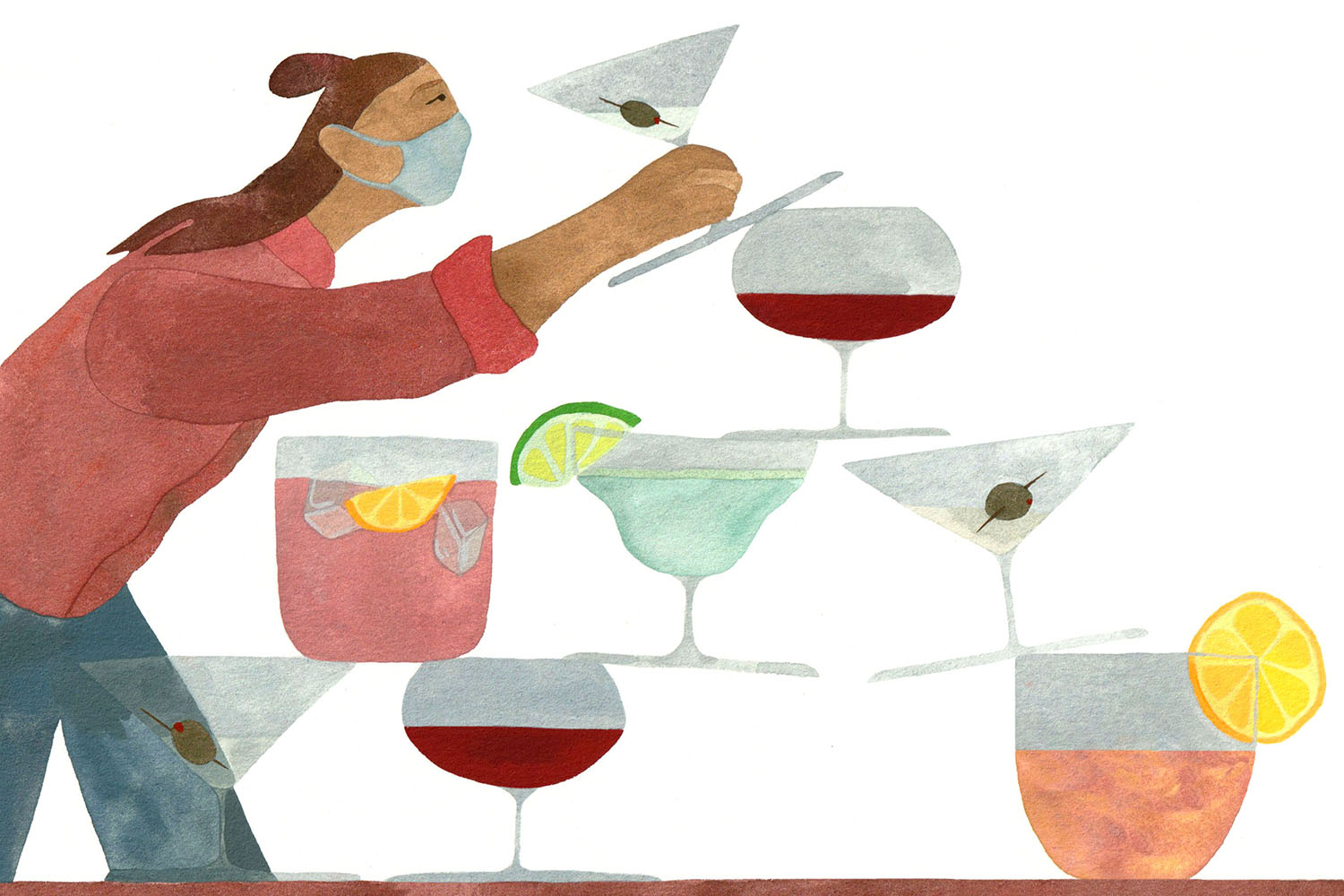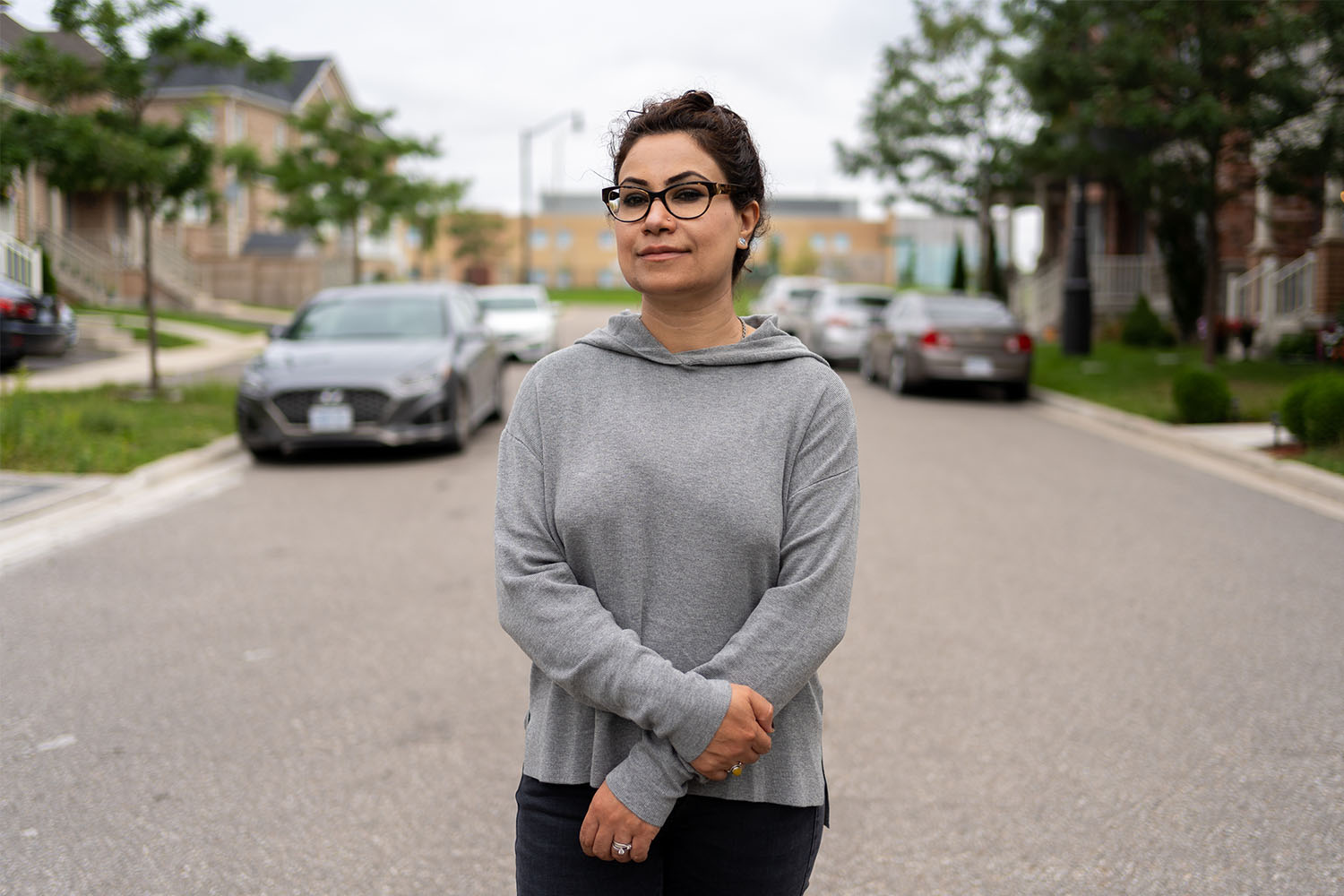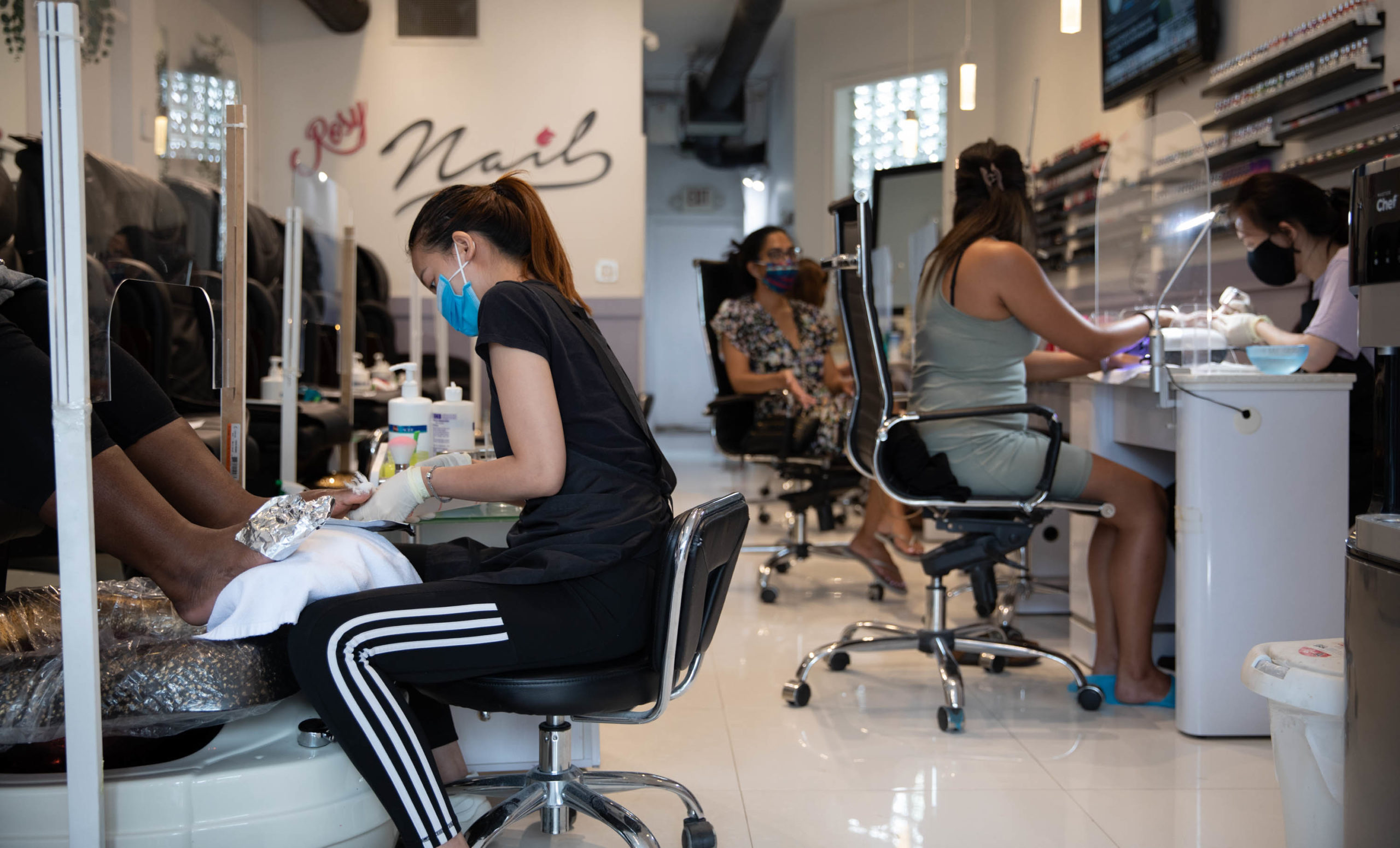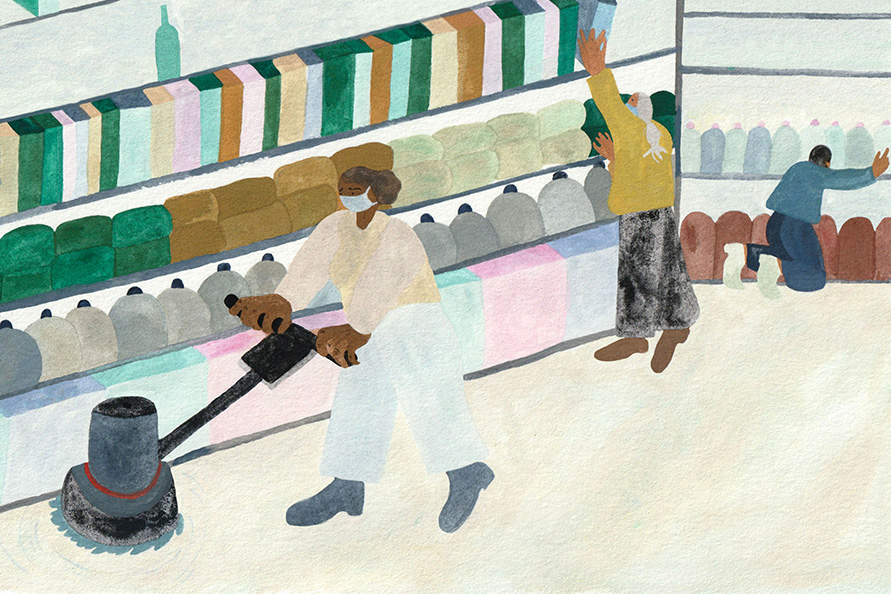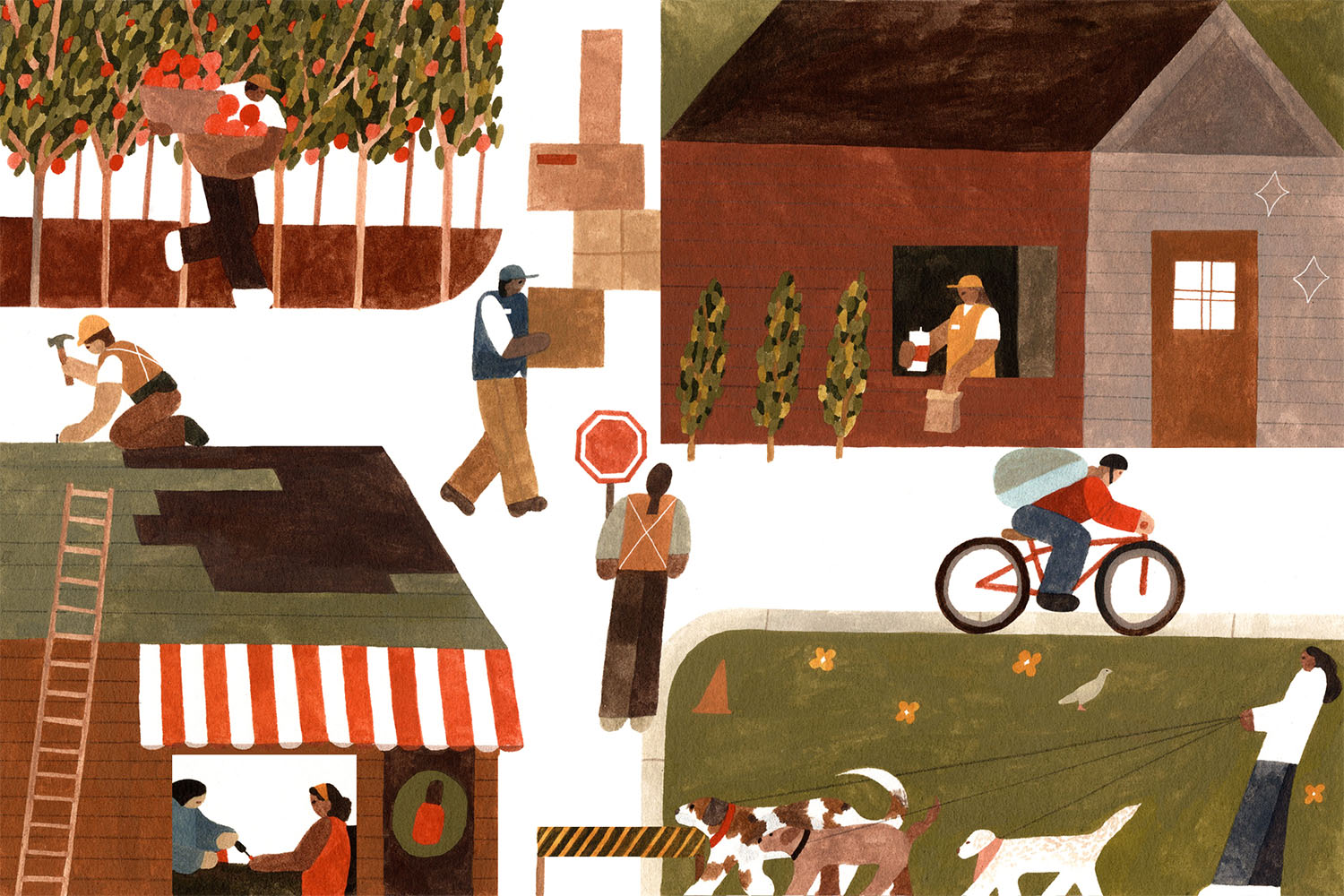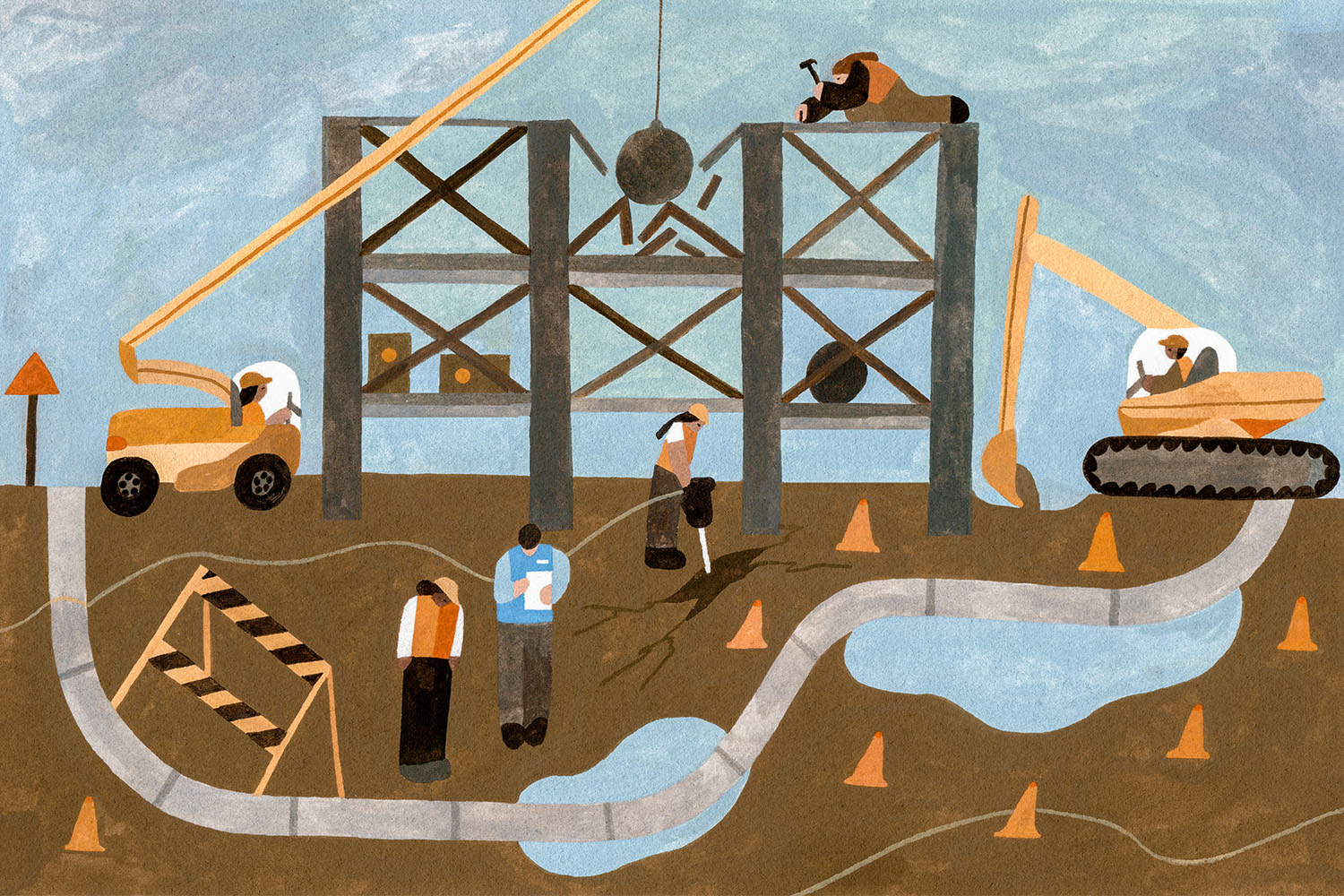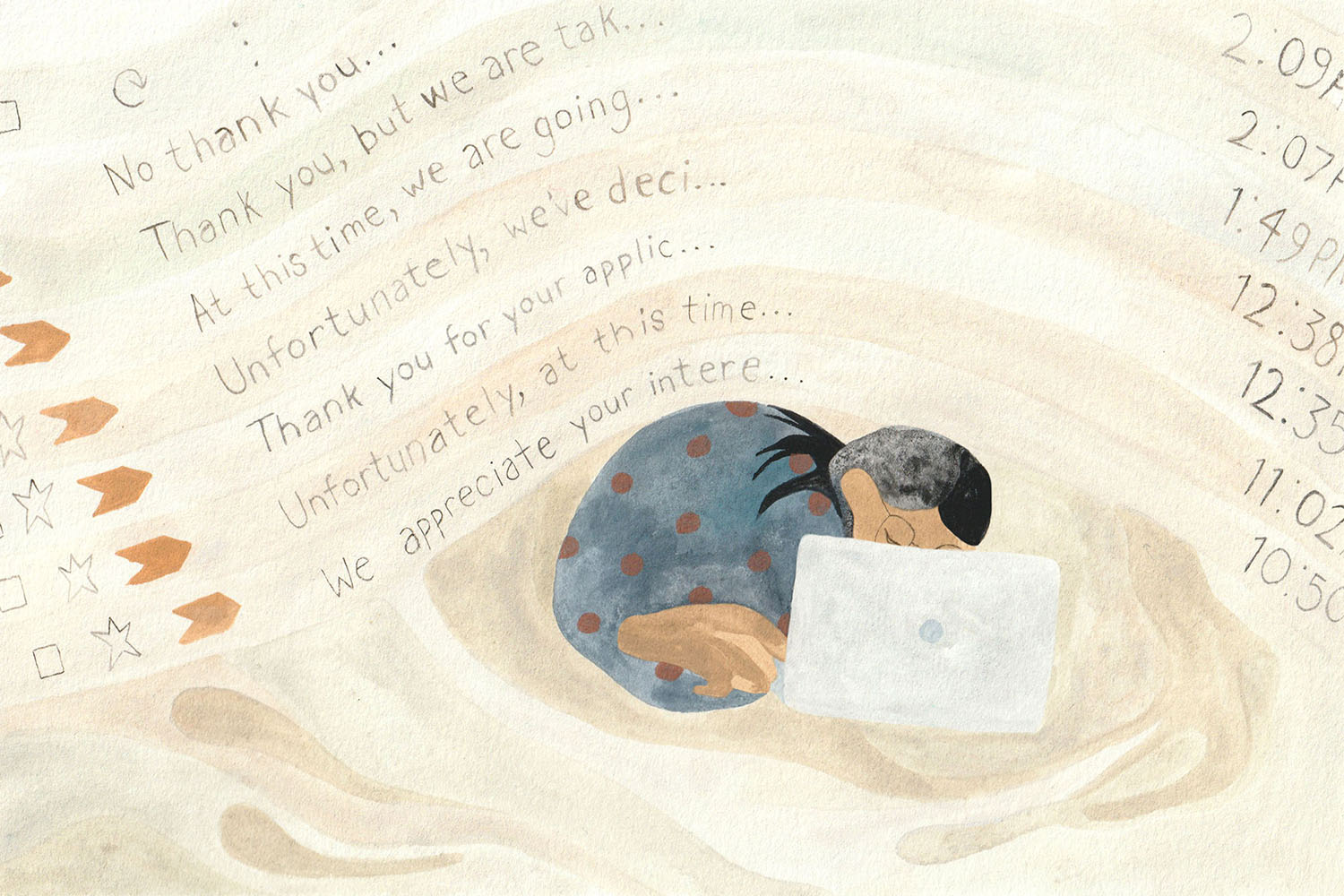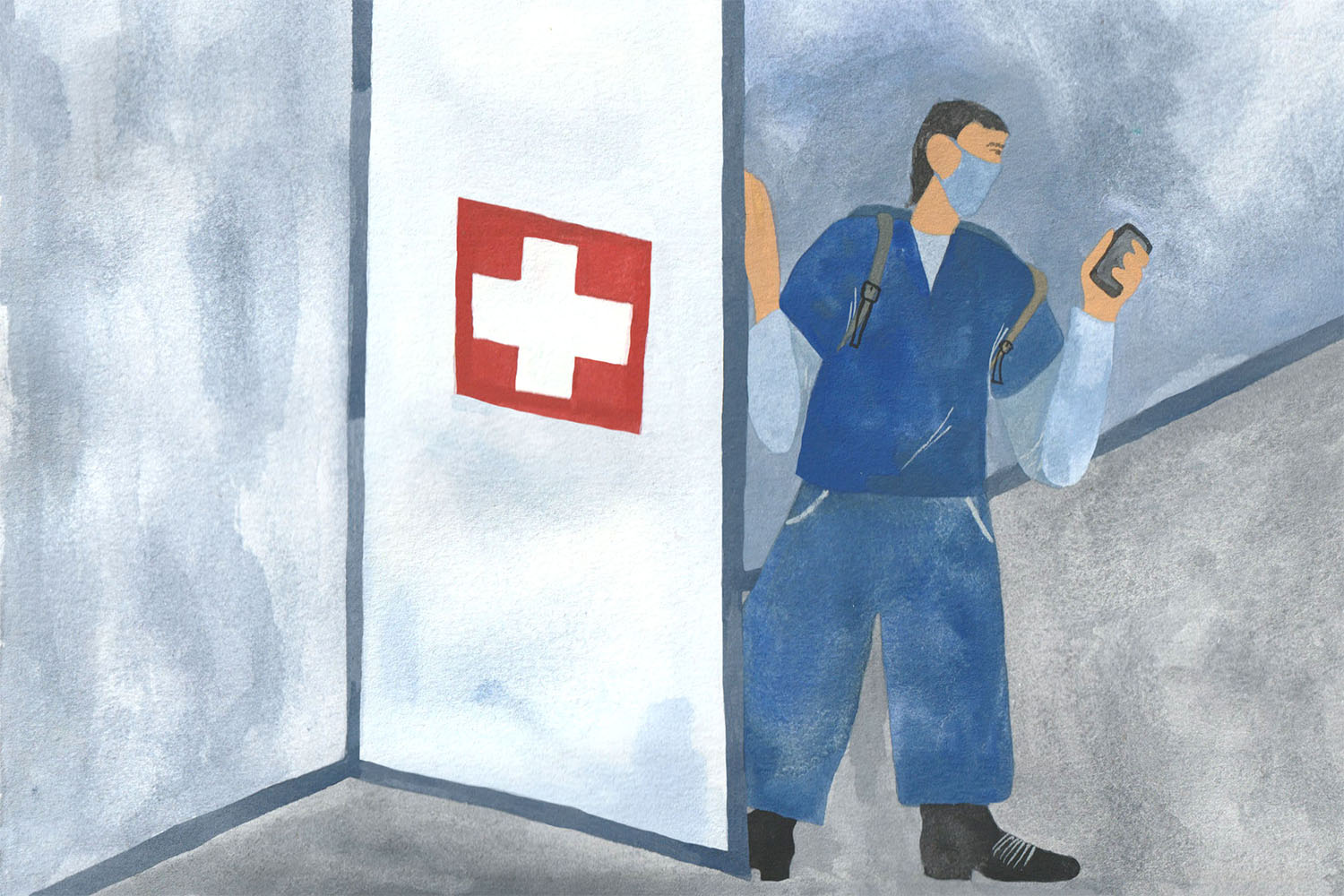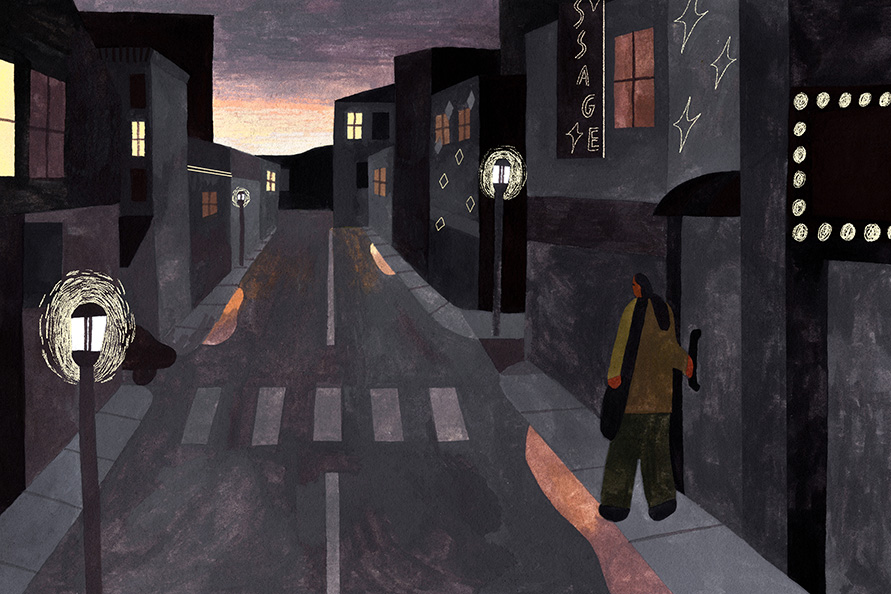
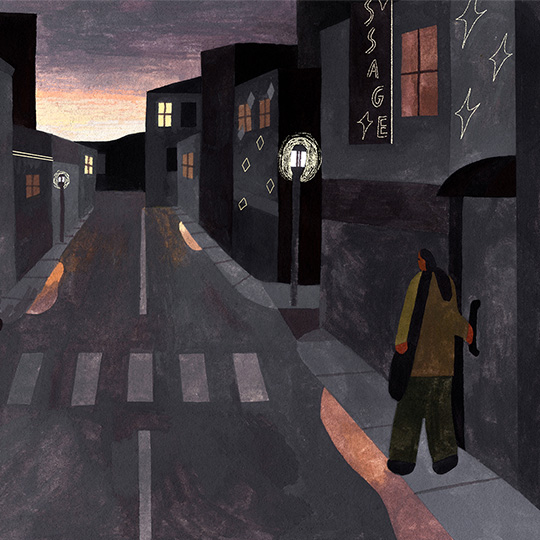
The Crown Spa sat along an unassuming strip of Dufferin Street in North York—a two-storey brick building painted all black that didn’t stand out among the neighbouring low-rises.
The spa was one of Toronto’s 25 licensed “body rub parlours,” the city’s parlance for spas that offer non-therapeutic and erotic massages. In Toronto, body rub parlours are confined to rigid zoning restrictions—they need to be at least 100 metres from residential zones and 500 metres from schools or places of worship—so many end up in semi-industrial areas like this stretch of Dufferin, just south of Wilson Avenue.
Now called Dream Spa and under new ownership, in 2020 the spa had a layout similar to most massage parlours in the city: a front desk reception area where clients can peruse an iPad with photos of the women working that day, and private treatment rooms—unlocked, in accordance with a city bylaw that prohibits body rub parlours from locking their doors. The previous owner had already been fined thousands of dollars for breaking the rule, according to city tribunal records.
Ashley Noell Arzaga started working at Crown Spa in February 2020 to support her five-year-old daughter. At the time, she was studying part-time at CDI College to become a PSW. Working at the spa was only going to be temporary, until she finished school. After graduation, she wanted to work at the retirement home across from her older sister’s house in Scarborough. “She wanted to help people,” says Kirsten Singh, Arzaga’s older sister. “Even before Ashley had her own daughter, she’d babysit her friends’ babies. I think she liked being able to help people when they needed it.”
On February 24, 2020, Arzaga was working the day shift at Crown Spa when a 17-year-old boy walked in just after noon. Armed with a machete, the 17-year-old allegedly stabbed Arzaga near the front desk, according to a former co-worker who was also injured in the rampage. When police arrived around 30 minutes later, Arzaga was pronounced dead and the alleged attacker was arrested.
The 17-year-old, whose name is protected by the Youth Criminal Justice Act, was charged with first degree murder and attempted murder pursuant to alleged terrorist activity. Police say that the attack was inspired by the misogynistic “incel” ideology. Short for “involuntarily celibate,” the incel movement is a largely online subculture made up of angry young men, some of whom call for violence against women. When Robert Aaron Long went on a shooting rampage in Atlanta-area massage parlours in March 2021, killing six Asian women, he would later tell police his motive was to “eliminate the temptation” of his sex addiction.
The attack at Crown Spa reverberated through the community. Advocacy groups were furious that despite years of calling for greater protections, their warnings had gone unheard. Some workers felt too scared to go back to the spas, according to the former co-worker. But many continued to work as usual; they had to support themselves and their families.
The murder wasn’t an isolated incident. It’s part of a larger problem in which Canada’s prostitution laws leave Toronto sex workers facing harm both from clients and the authorities who are supposed to protect them. All of these factors put workers at greater risk. This past June, the provincial government passed new legislation that gives police and other law enforcement increased power to investigate suspected cases of human trafficking, which advocates say will lead to increased surveillance of racialized sex workers, pushing them even further underground and into potentially more risky workplaces.
Arzaga’s death was a tragedy. But without overhauling our sex work laws, advocates say, the violence facing some of our most precarious workers will continue.
“I don’t think people realize how common sex work is,” says Jenny Duffy, the board chair of Maggie’s Toronto Sex Workers Action Project, one of Canada’s oldest sex worker justice organizations. “They probably know people who are sex workers.”
Indeed, Toronto’s sex industry is wide-ranging and reaches every corner of the city. It includes outdoor soliciting, brothels and in-call apartments tucked inside swanky downtown condos, massage parlours, escorting, exotic dancing, camming, pornography, and BDSM work.
Depending on the type, sex work is legal to varying degrees. Massage parlours are licensed in Toronto, but it is illegal to advertise sexual services. Strip clubs are legal, but there are rules prohibiting physical contact with clients.
The city counts 25 body rub parlours, 410 licensed holistic centres as of 2016 (with more than 25 percent offering unauthorized erotic massages), and fewer than a dozen strip clubs dotting the GTA. In the 1970s, more than a dozen strip clubs were on Yonge Street alone, but it’s become nearly impossible for aspiring club owners to find space due to city zoning restrictions. Meanwhile, it’s hard to know exactly how many Toronto-based sex workers are on online networks like OnlyFans.
When Elene Lam moved to Toronto in 2012, she had no intention of becoming an advocate for workers in this city’s sprawling sex work industry. In Hong Kong, Lam had been involved in sex work organizing and the anti-violence against women movement for around 20 years, but in Toronto she planned to take a break from organizing and focus on her studies as a masters student in social work at York University. It was a decision made easier by the fact that Canada was already home to strong sex worker advocacy groups, like Maggie’s in Toronto, and that for the most part the police weren’t enforcing the laws prohibiting prostitution. But speaking with Asian and migrant sex workers as part of a placement at St. Stephen’s Community House, Lam heard that they were still being targeted by police at massage parlours, and sometimes even detained and deported.
Around that time, two Asian sex workers were murdered in Toronto: Jiali Zhang, a 40-year-old Chinese national in 2013, and Evelyn Bumatay Castillo, a 43-year-old Filipina mother and caretaker in 2014.
“The [government] had no concern about those murders,” says Lam. “Some of the Asian and migrant workers said we should start an organization that can support one another.”
In 2014, Lam co-founded the Toronto-based grassroots group Butterfly: Asian and Migrant Sex Workers Support Network. The group funds legal services for workers facing deportation, provides translation services, and operates a 24/7 hotline in English, Cantonese and Mandarin. During the pandemic, the hotline received over 500 calls in one week from workers desperately seeking advice on how to access government supports like CERB, prompting Butterfly to launch their own emergency fund since many people did not qualify.
For years, Butterfly has sounded the alarm on the violence sex workers were facing in Toronto’s massage parlours, where the majority of workers are Asian women. In a 2018 survey conducted by Butterfly, around 20 percent of workers said they experienced physical sexual assault, 36 percent experienced robbery or theft at their workplace, and 11 percent experienced threats from gangs. Last October, two men were arrested in connection with a string of violent knife-point robberies that occurred from February to March 2020 at Toronto spas and massage parlours. The men posed as clients and once inside, held a knife to the victims’ throats while demanding money.
Yet through an access to information request to the city, Butterfly found that the number of investigations of holistic practitioners—some of which offer erotic massages in addition to services like reiki and aromatherapy—rose from 611 in 2013 to 2,585 two years later, going from 3.7 percent of all investigations to 19.3 percent.
For Lam, this shows that heightened police presence doesn’t lead to safer working conditions. In fact, it can lead to more harm.
After the murder of Arzaga, Butterfly and around 500 massage parlour workers petitioned the city to change the bylaw surrounding door locking, which Lam argued would help protect workers. Another bylaw prohibits massage parlours from installing any security cameras, which workers say would add another layer of security.
Six months after the attack, in August 2020, the city announced a moratorium of the door locking bylaw’s enforcement. In a statement to The Local, the city says that the “enforcement of the locked door provision for body rub parlours will continue to be suspended” until the city resumes its review of the bylaw, which was scheduled to be completed in 2021 but has been delayed due to the pandemic.
The moratorium felt like the least the city could do—between July 2019 and June 2020, more than 60 workers in Toronto massage parlours reported being robbed, according to internal reporting by Butterfly.
“[The moratorium] was an important step because the city realized some of the harm of the law on workers,” says Lam. “But we also need to eliminate the discrimination of sex workers.”
For decades, Canadian sex workers have argued that the only way to make the industry safer is through full decriminalization, not abolishing the industry altogether.
For a short period in 2013, sex workers were optimistic that long-awaited reform was finally coming to Canada’s prostitution laws. That year the Supreme Court ruled in favour of a coalition of sex workers, declaring that the current laws were unconstitutional and harmful to sex workers. Known as the Bedford case, the ruling struck down laws prohibiting bawdy houses, living off the profits of sex work, and communicating in public for the purposes of prostitution.
“It was really affirming for sex workers who had internalized this notion of violence as an occupational hazard,” says Jenn Clamen, the national coordinator of the Canadian Alliance for Sex Work Law Reform, a group made up of 25 sex worker groups across the country. “I remember when a sex worker who was working on the street said to me, ‘Oh you know, [the violence] is part of the job. It’s an occupational hazard.’ When the instruction is given to people to expect that violence in their lives, it invites violence. It tells predators, hey, if you’re looking for easy prey, it’s sex workers.”
The hopefulness around the Bedford case did not last. In 2014, a year after the Supreme Court’s ruling, the Conservative government passed Bill C-36: Protection of Communities and Exploited Persons Act (PCEPA), based on the premise that the best way to make sex workers safer is by eliminating the sex industry altogether. On its website, the department of justice writes that the PCEPA was designed to “encourage those who engage in prostitution to report incidents of violence and to leave prostitution” and “reduce the demand for prostitution.” The laws purported that clients—and not sex workers—would be criminalized. The laws made it illegal to buy, advertise or benefit from the sale of sex, meaning that third parties—like drivers, security and receptionists—could also be charged if found associating with a sex worker.
For many sex workers, these police powers have not made them feel any safer. Jennifer, who asked to use a pseudonym to protect her identity, has worked in strip clubs in Toronto and the GTA for 15 years. She first started in the industry when she was a “broke college student” who needed to make ends meet and has stuck with it for the freedom that a traditional 9-5 doesn’t offer.
She says that her interactions with authorities—whether police or bylaw officers—often leave her feeling like she’s a criminal. She recalls the dehumanizing experience when bylaw enforcement officers inspect strip clubs and dancers are pulled off the floor, told to lineup against a wall and show their licenses. “You often don’t have time to put on a robe, and now you’re standing in the lineup, in your high heels and lingerie, and there’s a stranger looking you up and down multiple times to verify your ID,” says Jennifer. “Sometimes there are comments, like ‘What’s a nice girl like you doing here?’ or ‘Oh you’ve had your license for X amount of years. When are you going to quit?’ You’re the bylaw guy, how is that your business?”
Meanwhile, during these inspections, Jennifer says bylaw officers will ignore the fact that the majority of the toilets in the dancers’ change rooms are broken.
Jennifer notes that in strip clubs, she’s noticed it’s more likely that Black workers will get ticketed for small offenses, like touching clients, than their white co-workers.
Duffy also sees how race impacts how the laws are enforced. She says that Black, trans and Indigenous workers are regularly charged with crimes related to their profession and other minor offences. These minor offences can add up to thousands of dollars in fines for infractions like drug possession, jaywalking and loitering. During the pandemic, Maggie’s hear so many complaints about bylaw officers booking appointments and then posing undercover to give out social distancing tickets, that Maggie’s teamed up with the law firm Biking Lawyer to provide legal advice.
Jennifer has heard “horror stories” about off-duty bylaw officers and police in Toronto committing one-on-one violence during private dances. “There’s not much that you feel you can do,” says Jennifer. “First there’s the victim shaming toward sexual assault survivors and the stigma of sex work, then you add that the perpetrator is law enforcement, and the probability of receiving meaningful justice becomes so slim.”
In 2013, a police constable was convicted of sexually assaulting a masseuse during a supposed inspection. These kinds of stories not only fuel distrust of authorities, but also force workers to seek help elsewhere when they are in dangerous situations. “Nobody reaches for the phone to call 911,” says Jennifer.
Anna-Louise Crago, a former sex worker and researcher who studies sex worker rights, co-authored a study published in January in the peer-reviewed journal, Social Sciences that surveyed 200 workers. It found that one-third would not call 911 during an emergency due to fear of police detection. (Indigenous workers specifically were twice as likely not to call as non-Indigenous workers). Sex workers who reported experiencing police harassment in the previous 12 months were five times less likely to call.
“If the aim of the law was to combat trafficking and to support sex workers to report violence, it clearly failed,” says Crago.
Since the 2014 laws have been in effect, Stats Canada data shows that there’s been an overall decrease in charges against sex workers in Canada. On the surface, that might seem like a positive outcome for the law. But Clamen says organizations across the country haven’t actually seen a decrease in sex workers, nor in the number of clients seeking services. Although police are laying fewer charges related to sex work, workers are still facing harassment from police, in turn increasing their overall fear of arrest.
“Imagine getting constant unsolicited visits from police in your workplace,” says Clamen. “It’s an extremely violating moment and it’s scary for people. When you’re criminalized, you don’t experience police in a ‘serve and protect’ kind of way. You experience them as antagonistic.”
When Justin Trudeau’s Liberal government was first elected in 2015, his party said they would overturn the 2014 laws. But in the half-decade they’ve been in power, the federal government has not made any progress.
That’s why this past March, the Canadian Alliance for Sex Law Reform officially launched a constitutional challenge against Canada’s federal sex work laws, stating that they violate sex workers’ Charter rights to security, personal autonomy, life, liberty, free expression, free association, and equality. The challenge is currently in the Ontario Superior Court of Justice and is expected to go to trial in 2022.
“The government is no longer listening, we have to move forward because the harms are happening now,” says Clamen.
Meanwhile in Ontario, workers and advocates fear that newly passed anti-human trafficking laws will push workers even further underground, where they’ll have even fewer protections.
In June, the province passed Bill 251, Combating Human Trafficking Act, new laws that are a part of a larger $307 million strategy to prevent child sex trafficking and support victims. The bill will require hotels, motels, and other accommodations like Airbnbs to keep a register of all guests, which law enforcement will be able to access. It also gives law enforcement the power to enter any place not classified as a dwelling at any time without a warrant and question individuals. If an individual refuses to answer questions potentially connected to an investigation, they could be fined up to $50,000.
Lam of Butterfly says the bill gives police unchecked power to racially profile and target workers, pushing them further underground. She says that Asian and migrant workers have been wrongfully labelled as human trafficking victims and when they tell police they’re not victims, agents with the Canadian Border Services Agency have been notified.
For decades, Canadian sex workers have argued that the only way to make the industry safer is through full decriminalization, not abolishing the industry altogether. And it’s also not by giving police and bylaw enforcement more money and power.
Clamen points to New Zealand as a decriminalization model that Canada could follow. After the decriminalization of its sex industry in 2003, workers reported more positive relationships between police and an increased ability to report violence and exploitation to authorities.
“Sex worker rights is a really important feminist battle, a labour battle, and a human rights battle,” says Clamen. “It’s something that crosses so many communities; it changes how people understand the world.”
“Sex worker rights is a really important feminist battle, a labour battle, and a human rights battle.”
The trial for Argaza’s alleged attacker is set for September 2022 and will last five weeks. The case marks the first time an incel-inspired attack is being treated as an act of terrorism in Canada.
When Singh thinks of her sister today, she remembers her as a child, visiting their mother’s family in the lush countryside in the Philippines. The trips were a nice change of pace from busy city life in Scarborough. Arzaga and Singh loved playing with their cousins, spending time with their grandma, and riding scooters. Whenever she got the chance, even if it was just a short trip to the store, Arzaga would beg a family member to take her on the scooter, which had a passenger sidecar. “Her favourite thing to do was to sit on the back of the motorcycle because it was like living on the edge,” says Singh. “Rather than sitting in this enclosed car, she could hang over the back.”
Arzaga’s daughter is seven now and just started grade 1 this fall. She lives with Arzaga’s mother, but she also spends a lot of time with Singh and her husband and their two young kids. “Whenever I see [my niece], she tells me things like, ‘Oh, you look like my mom, so when I’m sad, I’m going to look at you,’” says Singh.
Since the attack, Singh has gone over the circumstances over and over again. “It’s rattled around in my head: What could have been a safer approach? What could be done to make it a safe environment?”
In the days after her murder, one of Arzaga’s best friends set up a GoFundMe to help cover funeral costs and provide financial support for her daughter. On the fundraiser page, she listed what friends and family loved about Arzaga: her smile and contagious laugh, her positive attitude and outgoing personality, and how much she loved her family.
She was a mother, daughter, sister, cousin, and a vulnerable worker in an industry that’s not given enough protection.

